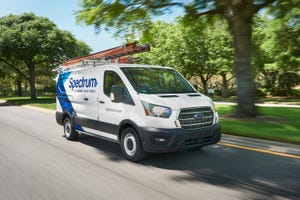C-V2X: A Turbo Boost for Connected Cars?
An emerging cellular technology could speed the autonomous vehicle toward reality.

PRAGUE -- 2020 Vision Executive Summit -- For the last 15 years, the car industry has been tinkering like a never-satisfied mechanic with a technology called digital short-range communication (DSRC), or 802.11p. An IEEE-developed WiFi standard, DSRC is supposed to let a vehicle communicate with roadside infrastructure and systems, not to mention other vehicles. If the autonomous car is to one day become a reality, this capability will obviously be as critical as the brake pedal in any of today's vehicles.
But it might not come through DSRC alone. An emerging mobile technology known as cellular vehicle to anything (or C-V2X) is changing the roadmap entirely, according to Steve Bell, a senior analyst with the Heavy Reading market research group. C-V2X has the potential, says Bell, to navigate the pitfalls and drops that carmakers have previously encountered on the cellular journey. It could speed them more comfortably toward the finishing line of 5G.
So just what is C-V2X, and why is it so important?
For starters, the technology would make use of much of today's network infrastructure, built to support 4G communications, to provide connectivity services for cars and trucks. This would clearly reduce investment needs and give the car and telecom industries the expansive network they will need for certain applications.
Figure 1: Speeding Ahead  With its Model S and other hi-tech vehicles, Tesla has been at the forefront of the connected car industry.
With its Model S and other hi-tech vehicles, Tesla has been at the forefront of the connected car industry.
What really rings Bell's bell, though, is that C-V2X wouldn't mean that DSRC disappears in the rear-view mirror, or need that big mobile network at all times. Right now, an industry group called the 5G Automotive Association, whose members include some of the world's biggest carmakers and telecom companies, seems eager to meld the best of DSRC with the advantages of 4G. "They are trying to promote this concept of using the software stack designed for DSRC on an LTE-based chipset," said Bell during a presentation at Light Reading's 2020 Vision Executive Summit in Prague this week.
This matters. The combination of DSRC and cellular would let car companies provide not only efficient vehicle-to-vehicle communications but also what Bell calls vehicle-to-pedestrian connectivity. "If you have a similar chipset that is doing direct-to-direct and also cellular LTE then the maker of the chipset starts to open up the ecosystem," says Bell. "You can also do network stuff, which links together with this whole roadmap of the car in a 5G future."
For all the latest news from the wireless networking and services sector, check out our dedicated mobile content channel here on Light Reading.
But C-V2X doesn't have to use the cellular network, and that's a paradigm shift for the industry. "It overcomes some of the barriers the carmakers have had," explains Bell. "One of those was the vehicle going dark if the network goes down. And vehicle-to-vehicle communications does not have to be SIM-based."
C-V2X could also support the industry's low-latency needs. In Germany, telecom incumbent Deutsche Telekom AG (NYSE: DT) is collaborating with BMW, Daimler and Mercedes on trials of edge-computing technology aimed at reducing latency when vehicles are travelling on Germany's autobahns. Used in conjunction with distributed cloud facilities, C-V2X might open up new service opportunities.
Before | After |
Devices using cellular technology required infrastructure support | Cellular V2X devices can communicate direclty without any network support |
Low latency communication was not possible with cellular solutions | Cellular V2X technology supports low-latency needs for V2V |
Cellular solutions require use of (costly) licensed spectrum | Cellular V2X technology can operate in the ITS 5.9GHz band |
Celluar solutions lacked mechanisms to address privacy issues | Cellular V2X operates without SIM cards and enables anonymity on par to DSRC |
Challenges to deploying interoperable V2V ubiquitously in an economical manner | Cost-effective means to accomplish the same objectives globally may now be available |
DSRC was the only technology available to support V2V | Cellular technology is a viable alternative to meet or exceed V2V requirements |
Source: Heavy Reading. |
Elsewhere, trials of C-V2X are underway. In late October, mobile phone chip giant Qualcomm Inc. (Nasdaq: QCOM) launched one in San Diego with AT&T Inc. (NYSE: T), Ford and Nokia Corp. (NYSE: NOK). In that instance, Qualcomm's technology supports direct communications, while AT&T's 4G network provides the wide-area capability. Nokia, meanwhile, has brought its edge-computing expertise to the party. The tests are using C-V2X technology running over spectrum in the 5.9GHz band to test vehicle-to-vehicle safety features. Real-time mapping updates and event notifications are being relayed over AT&T's network and Nokia's cloud systems.
The industry clearly has a long way to go before the fully connected car is more than just a talking point. In the regulatory area alone, the makers of self-driving or semi-autonomous vehicles will have to get around numerous roadblocks, regardless of what happens on the technology front. But there already appears to be widespread support for the idea that C-V2X will play a big part in the connected car's future. When respondents to a recent Heavy Reading survey were asked which technologies would be used for autonomous vehicles, an overwhelming 92.2% backed a mix of cellular and DSRC as either "high probability" or "medium probability" choices, making this combination the most popular of nine survey options. "C-V2X could be big," says Bell.
For more about the connected car, switch lanes and check out Light Reading's sister site The Connected Car, which provides regular coverage of the sector.
— Iain Morris, News Editor, Light Reading
Read more about:
EuropeAbout the Author(s)
You May Also Like




_International_Software_Products.jpeg?width=300&auto=webp&quality=80&disable=upscale)







